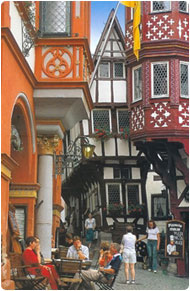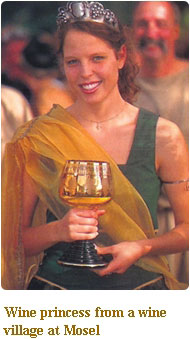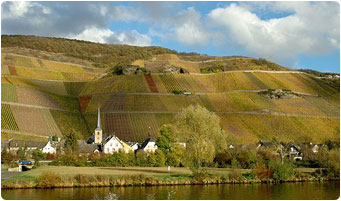
 |
Germany is one of the coldest and northern-most wine growing regions in the world. It is primarily the warm Gulf Stream and its tempering influence on Western Europe¡¯s climate that enables grapes to ripen this far north. This chilly climate makes for the longest, coolest growing season of any wine-producing country and accounts for naturally high acid levels in the finished wines. Nevertheless, the climate and weather in Germany¡¯s wine-growing regions pose challenges to viticulture that are unknown in the Mediterranean region. Therefore in Germany, the quantity and quality of each vintage depends considerably on weather conditions, a factor that plays much less of a role further south.
Riesling is the "coolest" white grape variety of the world. Riesling is a late-ripening grape, and only has a moderate yield. This makes it difficult to grow. To reach its full potential, Riesling needs extra days of sun; ripening is very late, usually not until the latter half of October. Riesling normally ripens between late September and late November, and late harvest Riesling can be picked as late as December. Riesling vines are particularly hard-wooded and tolerant of cold weather and they bud late, so are well-suited to the coldest wine-growing climes. Much rain and humidity produce mold on a grape.
Germany is Riesling¡¯s homeland. Here the cooler climate allows the grape to ripen over an extended growing period and the predominantly slate soils impart a mineral component to the wine. Today Riesling is Germany¡¯s leading grape variety counting for approximately 20 percent of Germany¡¯s vineyards and more than 60 percent of the worldwide area planted with Riesling is in Germany. There are 13 wine-growing regions in Germany and the major wine regions are the Mosel (previously named as Mosel-Saar-Ruwer), the Rheingau, the Rheinhessen, and the Pfalz. Particularly the Riesling wines of Mosel are among the most delicate of Riesling wines over the world. We also set a column in this website to introduce Mosel Riesling wine.
As ¡¯The King of White Wine Grapes¡¯, Riesling has a powerful and distinctive floral and fruit-like aroma often reminiscent of peaches, pear or when young, apples. It frequently mixes in mineral elements from its vineyard source and is often described as "racy" Riesling wine is also about balance, the subtle interplay of sweetness, fruit, acidity and alcohol.
German Riesling wine is known for its characteristic "transparency" in flavor, the natural high acidity, presentation of terroir, and its balance between fruit and mineral flavors which are its trademark around the world. Its long finish, complex flavors and crisp zest are the benchmarks that make German Riesling so unique and ideal for pairing with food.
Because of the harsher climate, Germany¡¯s vineyards are usually found on steep slopes, covered with a fantastic |
variety of stony, mineral-rich slates and soils, facing southward to assure the longest exposure to the sun. They are also often found in river valleys, such as the Rhine and Mosel which flow through them and create the unique conditions that distinguish these vineyards from all others in the world, because of the water¡¯s ability to moderate night temperatures and reflect the warmth of the sun. Besides, the river will keep temperatures moderate in chilly autumn and provide mists and fog to protect the vines from frost.
Germany¡¯s Riesling vineyards, usually quite small in acreage, are as diverse and special as the great, equally tiny, vineyards of Burgundy. Similar as in Burgundy, winemaking is mostly artisanal, meaning a small yield, usually family, affair where tradition reigns and wines are hand crafted.
|
Revival of German Riesling Wine
Germany has a history of winemaking that dates back to 2000 years ago. When ancient Romans, who conquered the region, began producing wines on local soil and laid the foundations for the hearty and merry hospitality associate with wine. Since 14th century, Riesling¡¯s popularity was starting to spread in Germany. Today, it is almost forgotten, but Germany and France were once revered as the two great wine producing countries in the world and German wines fetched top prices at auction.
Germany¡¯s wine production lost its luster in the 1960s and 70s, when large quantities of sweet blended wines like Blue Nun and Liebfraumilch were created for export, while Germany continued to make and drink high quality wines (most Germans have never heard of either brand). Sadly, the stigma of sweet non-descript cheap wines became synonymous |
 |
with German wines for decades internationally. Though the Riesling grape is sometimes used in the production of these wines, this category of wine has little to do with a true Riesling wine.
This marketing disaster made German wine makers realize they shall stick to low yields, late and selective harvesting, proper intervention wine making, and above all the interplay of Riesling grape and its most suitable terroirs to recapturize the reputation they once possessed internationally.
Meanwhile, tastes are changing, and younger consumers are interested in elegant, aromatic white wines and there is a global trend that lighter and healthier preparations are now firmly entrenched in all styles of cooking. These trends provide an ever larger window for fine German Riesling.
The Riesling revival is truly upon us and German Riesling has made a phenomenal comeback across the world! Global authorities on the subject, like Hugh Johnson, Jancis Robinson, or Stuart Pigott keep reminding the world that Germany¡¯s finest wines, usually Rieslings, are among the finest wines made anywhere on the globe. This can be seen as great news for consumers. German Wine Institute reports on an 18 percent increase in wine exports for the year 2006. UK accounted for 27% of export revenues and thus remains Germany¡¯s most important foreign market, followed by the USA and The Netherlands as well as Japan and Sweden.
German Wine, a Tradition of Quality
Germany deserves its reputation for combining viticulture, wine-making tradition and attention to quality. It has the world¡¯s most strict wine labeling law and wine law. According to the German wine law, each style of wine must have a minimum must weight, which is determined at the time the grapes are picked. In Germany, must weight is described in Oechsle degrees.
Among the most important legally required declarations on a label is a wine¡¯s quality category. The German wine law makes far more distinctions within the two broad quality categories mandated by the European Union wine law - table wine and quality wine - than other wine-growing countries.
Furthermore, every German quality wine undergoes a critical, blind, sensory examination based on a five-point scale devised by the DLG (German Agricultural Society). The testing procedure is divided into two essential parts: judging whether specific prerequisites have been fulfilled; and the examination of a wine¡¯s sensory characteristics with a "five-point system" which is also applied to determine which wines merit seals, awards and prizes. Only those wines which can achieve above 1.5 points can receive a quality control test number and can be launched in the market.
Choose the Right German Riesling
A crisp cool refreshingly light taste curls around people¡¯s tongue and warms their soul. Riesling wines have great diversity and variations in flavor, which can make it difficult to choose which Riesling is right for you.
Rieslings are a great place to start because they have something to offer to everyone. First, people need to identify what kind of flavor they are looking for, in that do they prefer dry or sweet wines. A dry wine evaporates from people¡¯s mouth leaving a complex fullness for their consideration, whereas a sweet wine tends to be more upfront and offers them a crisp light directness that does not linger like a dry wine. Rieslings are one of the few wines that retain its acidity while developing its sweetness thereby allowing you to find something in the middle as well. Dry Rieslings tend to have a greenish yellow hue and as it matures in sweetness, the color develops into a richer yellow deepening eventually into amber. This is possible because the qualities of the Riesling grape not only withstand aging but also actually improve the rich fullness of the wine and aroma.
Another factor people might want to consider is the purpose of their Riesling wine. Is it going to accommodate a meal? Are they drinking at the end of a long day just trying to relax? Or trying to impress a date?
German Riesling wine is low in alcohol. Most German Rieslings contain 7-11% alcohol, compared with 12.5-15% for most table wine. Low alcohol is very appealing and makes Riesling an agreeable aperitif.
German Riesling is among the food-friendliest wines on the planet. It accompanies an equal variety of meals. Pairing well with lighter fare like salad, seafood, or poultry as well as being acidic and rich enough to play along with bolder or spicier savory-with-some-sweetness kinds of food such as beef or pork dishes. And all kinds of Asian food, and Indian cuisines. It even offers a very sensual compliment to most desserts.
Style of German Riesling Wine
Contrary to the popular misconception that Riesling wines are always sweet, and they don¡¯t taste bone-dry either. The residual sugar and bracing acidity in good German Riesling are balanced, and as a result the wines taste balanced. Riesling varies from a dry, acidic wine, to a slightly sweet wine to a very sweet wine that can happen when grapes are affected by noble rot (botrytis) or frost.
Dry Riesling wines have taken a big leap forward in the past decade. They are very popular in Germany and are high demand items in restaurants, however few dry Riesling has been exported. The international perception of German Riesling is still only about that classic fruity sweet style. Another obstacle is consumer difficulty with German labels. We particularly put a column to share with you our knowledge on how to read a German wine label.
More than most other white varieties, the Riesling grape is very sensitive to its soil, climate, and growing conditions. Cool-climate Rieslings have an aromatic, delicate nose, while warm-climate Rieslings remind one of limes and other citrus fruits. The color varies from a very pale yellow with a slightly green and often brilliant tinge when young that evolve with age into a golden, honey-colored, possibly viscous wine. The taste varies from a crisp, acidic flavor when young to a rich, honey, spicy, toasty palate associated with the developed wine.
Vintage and Aging of German Riesling
Every vintage cannot produce large quantities of the higher Prädikat categories (QmP), but good and pleasant wines are produced every year in Germany. Wine is an agricultural product and consequently very dependent on the weather which in Germany, unlike more southerly climates, can be extremely variable.
Although different vintages may exhibit subtle differences in taste and style, the German classification system specified by wine law, based on ripeness, assures the consumer of the quality of each bottle, regardless of the vintage.
Wine making in the end is about art and creativity. Any way in the same vintage two different wine makers may produce very different qualities Riesling on the same terroir, showing that the name of the producer might be more important than the vintage itself.
Regarding aging of Riesling, how well it ages is determined by a large number of factors, which can be difficult to assess.
Most German Riesling of the QbA and Kabinett grades are ready to drink when you buy them. Buy these in a recent vintage to enjoy their youthful freshness. At most, buy them when they are not more than four or five years old.
Spätlese, too, may be consumed young, but it is likely to be enjoyable even five to ten years after bottling. The higher grades the Auslese types are usually longer-lived, generally reaching their peak when they are from seven to ten years old. With good storage, they will continue at their best for many years thereafter versatile that not only can it age beyond our lifetimes. Its high natural level of Tartaric acid enables it to balance even high levels of residual sugar.
Fine Riesling can be extremely long lived. The more concentrated, in particular the higher in acidity and residual sugar, the longer it will usually improve. In the extreme cases, like Beerenauslese, Trockenbeerenauslese (TBA) and Eiswein, that can mean decades or even beyond our lifetimes.
Conclusion
A fine German Riesling is a magnifying glass for the landscape, a picture that the landscape creates. Riesling wines reflect not just the soil in which the grapes are grown but the sunlight, the slope, the other plants and even the animals that inhabit the land. Its natural aromas and grace, its transparency to terroir and its complexity it reaches with bottle age make the wines possess a vivid, chiseled quality that¡¯s unmatched anywhere else.
Lastly it is also a sound investment to carry them home, providing more than instant gratification. Like fine Bordeaux it can develop for decades. To predict that German wine will reach cult status in the not too distant future may be ahead of the fashion, but this is no reason to miss out on one of Germany¡¯s greatest cultural contributions to the world. A contribution that is less known but just as worth knowing about as Germany¡¯s contribution to the construction of fast automobiles, to perfecting the art of engineering, to producing unpenetrable philosophy and literature, and to brewing as well as consuming an ocean of beer.
| |

